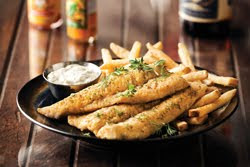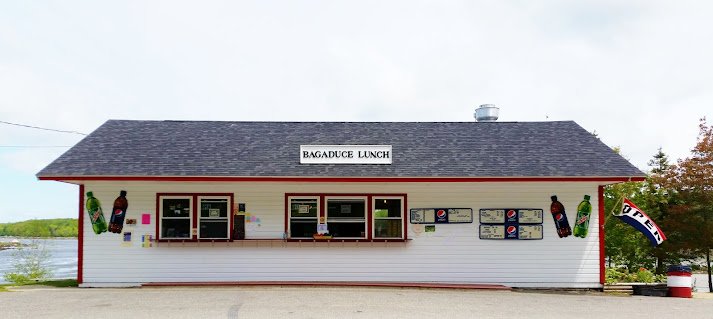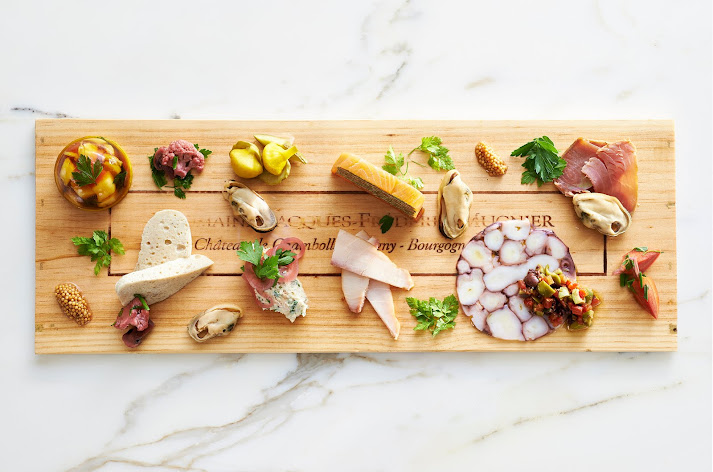In a world saturated with upscale menus,
we take the road less traveled across America to find the essence of a no-frills meal.
The open road is one of opportunity and romance, travel and leisure, and for us, a chance to explore the off-the-beaten-path stops that might otherwise have gone unnoticed. Oftentimes it’s the road less traveled and restaurant less publicized that can bring to the plate a meal, an experience and an atmosphere worth seeing again. Beginning on the coast of Seattle and ending in downeast Maine where rockbound shorelines are abound, this cross-country road trip is rooted in routes through Main Street. Here, the melody isn’t modernizing, and the food, the product, and the experience is founded on tradition. These restaurants offer a how-to on pleasing the traveler who’s beaten lengthy highway stretches and GPS malfunctions to find their dining destination is just up ahead.
TAYLOR SHELLFISH FARMS
In the Pacific Northwest, oysters are more than a bivalve of the hour, they are THE bivalve. Here, they are plucked directly from the sheltered inlets and islands of one of the greatest oyster regions in the country. And with that, the oyster bar prevails. Dispersed across the Pacific Northwest, the saturation of half-shell-focused eateries also calls for authenticity. So where better to start than back in time? With five generations of history behind it, we head to the tidelands and shallow waters of Taylor Shellfish Farms.

“It’s really special to deliver the food of your region, and that’s shellfish to the Pacific Northwest,” says Marcelle Taylor, whose great-great-grandfather began farming Olympia oysters in the crisp Puget Sound waters in 1890. An inlet of the Pacific, there’s something seriously simplistic about the complex product that grows throughout the network of marinas and waterways in the Puget Sound. Here, every tideland creates its own composite.
At Taylor Shellfish, they’re farming more than just the northwest-of-Seattle Puget Sound area and have perfected the growing method to match each locale. At Totten Inlet, a southern point of the Sound, beloved and delicate Olympia, Pacific and Virginica oysters are grown. Chapman’s Cove produces its Kumamotos, whose sculptured, fluted shell holds an oyster of nutty, sweet and clean flavors. At its farm in Willapa Bay, also south of Puget Sound, the wave and wind help to form the company’s briny Shigoku oysters, a proprietary oyster to the company. It’s a Pacific oyster that’s tide-tumbled so the bags flip with the flow of the tide. “It knocks off the frill and makes the meat nice and strong to give the oyster that crunch that you don’t typically get in a regular Pacific,” says Taylor.
In an effort to build a direct, sustainable relationship between the Seattle consumer and the Taylor Shellfish Farm family, the company created three neighborhood oyster bars, each tailored to its own community. Taylor Oyster Bar in Capitol Hill, the company’s first, is a reminder of the humble beginnings of fresh seafood in its rawest prime. The menu here reads raw oysters only and a few cooked, chilled and cracked market specialties like Dungeness crab and cocktail prawns. Geoduck sashimi and a smoked salmon plate are also on the list, accompanied by local wines, IPAs and pale ales, among others.
“We originally thought that people would come to Capitol Hill to buy shellfish retail to cook at home,” Taylor says. “But they were coming in and asking us to do the shucking. It quickly became less of a shellfish market and more of a true oyster bar.” Eating the Taylor family’s product is as transparent a process as ever, and following the oyster back to its pristine waters is simplicity at best at the company’s oyster bars, which recently expanded to include locations in Queen Anne and Pioneer Square.

Still selling about 95 percent of its product wholesale, they’ve gone beyond building a sound retail program for local Seattle consumers—this is truly developing the heart of their business. Product is delivered six days per week to more than 150 restaurants and chefs in the area. The national program is also one of recognition. The company is one of the largest shellfish producers in the United States, and with an infrastructure to send clams, mussels and oysters year round direct to distributor or chef, it’s a specialty worth looking into.
“And it’s as fresh as it can get because we own the entire process of the supply chain,” says Taylor. “We can manage every section, and we know exactly where it came from, when, and when it’s going to hit someone’s table. We like to say its tide to table and as direct as possible.”
SUNRISE BISCUIT KITCHEN
Crumbly and dense. Flaky and light. Buttermilk or milk? The local loaf is a hotly debated topic, but in North Carolina, one biscuit kitchen has tipped the scale. Just up the road from the University of North Carolina situates a drive-through-only restaurant that’s been crafting its tall, golden brown biscuits since 1977. “Calling us no frills is being very generous,” says David Allen, owner of Sunrise Biscuit Kitchen. The 460-square-foot Chapel Hill location serves up southern comfort to lines of cars and patiently waiting customers seven days a week.
Adapting his grandmother’s biscuit recipe from “a pinch of this, a sprinkle of that” into a meal fit for service, Allen’s technique and handling of the dough hasn’t changed.
“As a southern farm family, there were many to feed,” he says. His grandmother, who lived to be 100 years old, had 17 children—Allen’s mother was the youngest. “Biscuits were served at every meal—they’re hot; they’re fresh, and they fill you up.”
It’s just the essentials here. A snaking line of cars and a steady handout of product. But for a restaurant so steeped in tradition, Allen has recognized the need to adapt. Over the years, loyal customers discovered that if they came in the kitchen door, Sunrise would let them order. When word got out, he added a second register to handle the walk in customers. It’s a small addition, but convenience for customers is key after nearly 40 years of business.
“I was hesitant to do this—the drive-through was our focus,” says Allen. “But it’s improved our service to everyone.” The location still only holds up to 3 people in at one time.
Chicken breast, sausage, bacon, country ham, pork chop tenderloin, western steak and more are all available to be sandwiched between the golden buttermilk goodness. The Chicken and Cheddar Biscuit is the top seller in Chapel Hill; The Country Ham Biscuit reigning number one at the Louisburg location just 50 miles northeast.
These fluffy, flaky numbers are more than just a vehicle for sausage and gravy, fried chicken or sausage, they’re a way to the heart of customer’s mealtime memories. Yelp, Facebook, TripAdvisor—all of these review sites are surging with positive responses, five stars and suggestions that the mom n’ pop spot must be seen and tasted to be fully understood.
“Many people tell me that they have been coming to Sunrise since childhood,” he says. “We certainly take great pride in what we do. At all of our locations, we have very dedicated people working with us, and I think that it helps that they get such positive feedback from our loyal customers.”
BAGADUCE LUNCH
Featuring a dramatic shoreline caressed by waves, reaches from the Maine land mass stretch like fingers into the Atlantic; its peninsulas jut in and out of the sea with more than 5,000 miles of coastline and islands to boot. In Downeast Maine, where rockbound coastlines prevail, we head inland to Bagaduce Lunch. It sits quite literally on the edge of Brooksville and atop its namesake river. You might find that off-the-beaten-path description of the 69-year-old roadside fish shack to be an understatement, but that certainly does not mean it’s the path less traveled. Since its opening in 1946 when Sydney Snow built a small take-out window for locals and passerbys, Bagaduce has continued to be a family affair—Judy Astbury, Snow’s granddaughter, is in her 19th year.
Simplicity reigns here at Bagaduce with Haddock Sandwiches king. Fried haddock fillets veil the sandwich buns they’re served on, and on a busy day, that number can reach 65-70. Couple that with the crab meat and lobster rolls ordered on speed dial and plump fried clams fit for Paul Bunyan himself, this Mother’s Day-through-mid-September spot is doing something right.
Astbury and her husband have seen children grow up and loyal locals and visitors come back since they took over for Judy’s parents in 1997. It’s as much about family lineage here as it is about the cohorts of customers who have traveled on ME Route 175/176 here for generations.
Sure, its no-frills atmosphere has been subject of talk and taste for those in the surrounding New England area, but Bagaduce Lunch has garnered hype and celebration of its food and service from around the country. In 2008, it was named one of the James Beard Foundation’s “America’s Classics.”
And classic is stays. There’s no indoor seating here; just a white-paneled building with red walk-up windows that customers belly up to to place an order. They’ve grown in size, expanding and rebuilding as needed. Walk around the building, and 20 picnic tables are scattered amongst a scenic backdrop of the narrow Bagaduce River—a waterside view alone worth the penny paid. But at the end of the day, it’s the family’s ability to season after season put out good food and work a crowd that brings the people back.






























